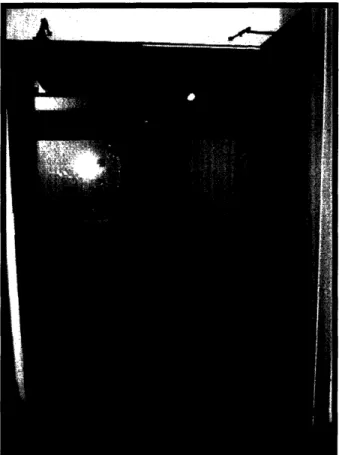Designing the Door: A Human Use Analysis
byFrances Omoleye Roberts
SUBMITTED TO THE DEPARTMENT OF MECHANICAL ENGINEERING IN PARTIAL FULFILLMENT OF THE REQUIREMENTS FOR THE DEGREE OF
BACHELOR OF SCIENCE AT THE
MASSACHUSETTS INSTITUTE OF TECHNOLOGY JUNE 2006
© 2006 Frances Omoleye Roberts. All rights reserved. The author hereby grants to MIT permission to reproduce
and to distribute publicly paper and electronic copies of this thesis document in whole or in part
in any medium now known or hereafter created.
Signature of Author: ' Certified bv:
Department of Mechanical Engineering
j May 12, 2006
(J, ii
Accepted by:
i/
Larry SassAssistant Professor of Architecture
Thesis Supervisor
Jo zW-ienhard V
Profesor of echanical Engineering
rman, Undergraduate Thesis Committee
MASSACHUSETTS INSTTUrE OF TECHNOLOGY AUG 0 2 2006
LIBRARIES
ARCHIVES
· - -Jr -- I_ _ - --. --.--. . 1Designing the Door: A Human Use Analysis
by
Frances Omoleye Roberts
Submitted to the Department of Mechanical Engineering on May 12, 2006 in Partial Fulfillment of the Requirements
for the Degree of Bachelor of Science
as recommended by the Department of Mechanical Engineering
ABSTRACT
Doors are essential objects that people use on a daily basis, however during the planning and design of buildings, they often appear to be overlooked from a human factors standpoint. The main functions of a door are to provide a way for people, animals, and objects to pass through an opening between and among outdoor and indoor spaces, regulating access in various ways and with consideration for several factors, including safety, energy loss, acoustics, and convenience. For the most part, we use doors giving little thought to their design or appearance. Bad door design, however, not only aggravates users but can lead to dangerous situations in the case of fire or emergencies. By identifying common problems with doors and entryways and determining workable design solutions to fix them, people can enjoy
unencumbered flow from one space to another. In order to make designers more cognizant of human factors, building codes should be updated to reflect a more human-conscious approach to the design of doors and entryways.
Thesis Supervisor: Larry Sass
Title: Assistant Professor
of Architecture
Acknowledgements
I would like to thank Professor Larry Sass of the MIT Architecture
Department for all his support during the work on my thesis and the rest of my time at MIT.
Introduction
In 2004, three would-be burglars in New South Wales, Australia, were foiled in their attempt to steal money from a restaurant, not by the bravery of patrons eating there or by the prowess of an astute owner, but by their
inability to read a simple sign: "Slide." They repeatedly kicked the door to the
restaurant to try to open it, but failed, because it was a sliding door.
Presumably their reading abilities were hindered by the fact that they were wearing balaclavas over their heads ("Dumb bandits"). This amusing story,
however, has more serious implications.
Doors are essential objects that people use on a daily basis, however during the planning and design of buildings, they often appear to be overlooked from a human factors standpoint. The main function of a door is to provide a way for people, animals, and objects to pass through an opening between and
among outdoor and indoor spaces, regulating access in various ways and with consideration for several factors, including safety, energy loss, acoustics, and convenience. For the most part, we use doors giving little thought to their design or appearance. It is a rare situation in which we notice a door: either for its exceptional splendor, surprising appearance, or frustrating
inconvenience. Bad door design, however, not only aggravates users but can lead to dangerous situations in the case of fire or emergencies.
Existing literature on the subject of doors falls into two main categories: beautifully illustrated books with pictures of expensive and uniquely designed
entryways and at the other extreme, texts describing interior construction standards in dry mechanical detail.
The first type of book shows examples of uniquely designed entrances for residential, public, and commercial structures. These are often part of buildings designed by well-known architectural firms and often offer little in the way of practical design of doors and entryways.
The second type of book, interior construction texts, serves to describe the construction details of door selection and installation. They include
practical information for architects on material selection, door type selection,
and door hardware.The goal of this thesis is to delve further into the human factors issues surrounding doors that are ostensibly often neglected. Integrating the issues of safety and ease of use into the design of entryways and understanding
strategies to improve the experiences of people with doors is valuable. Good design is often easy to ignore, whereas bad design leads to unintuitive and inconvenient objects to which people must learn to adapt. Doors should fulfill their intended functions while being as unobtrusive as possible. By identifying common problems with doors and entryways and determining workable design solutions to fix them, people can enjoy unencumbered flow from one space to another.
Background and Purpose
Doors are seen as parts of buildings, fulfilling (with arguable success) the task of facilitating entry between inside and outside, and among internal
spaces. Literature about doors encompasses a variety of types, some of which are now discussed.
The book Graphic Standards Details: Openings covers several types of openings: operable walls, vestibules, gateways, interior transitions, canopies, and sculptural openings. Although at times "openings are the subject of great
architectural interest as well as extraordinary technical difficulty," this is not
the case in the majority of building projects (Talarico 2). Each of the 21 examples (such as the Reuters Building entrance in Times Square in New York City or the canopies at the Corning Museum of Glass in Corning, New York) is exquisitely photographed and accompanied by thorough drawings detailing the installation mechanisms. The entrances examined in this text are thoughtfully designed, and they do take into account human factors, however, these doorways are designed for unique buildings and have limited features that can be applied to a wide range of building types.Interior Detailing and Construction for Designers and Architects is an architectural guide that has a chapter on doors and frames. This chapter describes in detail different types of doors and their advantages and disadvantages. It gives information on materials from which doors can be manufactured, and has precise information on the installation of various types.
Industry specifications and drawings are provided as well. The information may
be useful for determining what type of door to install in a particular location,
but with the exception of including some guidelines for accessibility from the Americans with Disabilities Act (ADA), this source has no pertinent advice regarding human factors concerns about doors.A 1978 MIT M.Arch thesis by John Stewart Roberts titled Languages of Entrances explores a more philosophical approach to doors and entrances, attempting to understand the ways in which architecture and in particular entrances convey meaning to people (Roberts 66). Roberts' thesis takes archetypal shapes of entrances such as arches, Palladian motifs, and
pediments, and explores the historical background related to these forms and the modern-day (albeit modern in 1978) connotations associated with them. Roberts focuses on a more sentimental way of looking at entrances, thinking about their function and trying to understand how their forms shape our attitudes to our surroundings and the interaction of entrances with other architectural elements (Roberts 7). Though Roberts acknowledges and even acclaims the importance of entrances, his ideas hearken back to a time before things such as the ADA requirements and great advancements in building technology. His work, while interesting, is not so much a design guide as a
historical and cultural exploration of the way in which we understand entrances.
The Americans with Disabilities Act of 1990 was passed by George H.W. Bush in order to "establish a clear and comprehensive prohibition of
discrimination on the basis of disability" (Americans with Disabilities Act). As
part of the enforcement of this act, the Department of Justice published the
ADA Standards for Accessible Design, Last updated in 1994. This document outlines in great detail design requirements for buildings and facilities in order to be maximally accessible for individuals with disabilities. These ADA
Standards, similar to Interior Detailing and Construction, offer a pragmatic way to ook at planning and design of doors and doorways. Full of numbers and angles, however, these standards often seem to leave out the human aspect of entryway design.
In his tome A Pattern Language, Christopher Alexander writes about towns, buildings, and construction in a matter-of-fact manner focusing almost entirely on humans' interaction with their surroundings. Alexander's insights all have the intent of imparting practical advice in order to improve human experience in our surroundings. Instead of advocating fitting doors into a design hastily, after spaces are created, Alexander notes, "Finding the right position [for a door] is a subtle matter. But there are very few ways of building which take this into consideration." Designers must focus on inner and outer spaces and their relationships to each other in carefully determining the
placement of a door (Alexander 1047). Alexander's thoughtful work shows that there are architects considering the human element in the details of a building. Throughout his work, he points out the numerous ways in which architects overlook human factors and the simple ways in which peoples' experience with their surroundings could be improved.
Donald Normans book The Design of Everyday Things, originally titled The Psychology of Everyday Things is a book about designing products with a human focus. Products should be intuitive and not intimidating for users. Norman specifically mentions doors and uses them as an example to explain affordances. Affordances are the "perceived and actual qualities of the thing,
primarily those fundamental properties that determine just how the thing
could possibly be used" (Norman 9). Door hardware is a prime example of how
people use affordances. People assume that knobs are for turning, a long bar is for pushing, or a short vertical handle is for pulling. These are implicit clues inferred from the shapes of these objects. Using affordances to design door hardware forges a connection between the object and the cognitive
involvement of the user. Surprisingly, though this source is not architectural, it provides some of the most relevant information in terms of designing doors optimized for human use.
A look at a broad variety of sources that consider doors and their interactions with people leaves one disappointed. The architectural sources that one would hope to have pertinent and helpful information regarding human interactions offer either custom design case studies or simply provide basic structural and mechanical information about.
This thesis now explores several doors with design flaws that make them frustrating or inconvenient to use and proposes fixes that would serve to
increase these doors' intuitiveness, safety and ease of use.
Hypothesis
Architects and designers are required to complete detailed construction plans for any building project. Much time and effort goes into designing each individual piece of a plan. Before it is actually constructed, each door's critical components such as doorframe, hinges, and lockset are resolved in excruciating detail. For this reason, it is hard to believe that architects simply ignore or do not care about human interaction with doors. I feel that the overwhelming details and regulations surrounding the building of even simple structures lead architects to do what is easiest and within all the necessary building codes. This does not, however, necessarily lead to the best doors for users. Since a door's primary function is to allow people to flow in and out easily, anything that interferes with this is a design flaw.
Observing humans more and learning about their interactions with spaces would improve door design, but the average architect may not have the time or resources to do so. Many of the human factors issues regarding doors have little or nothing to do with an incorrect use of materials or neglecting to follow proper building codes. Therefore, in order to make designers more cognizant of human factors, building codes should be updated to reflect a more human-conscious approach to the design of doors and entryways.
Problems and Proposed Solutions
On MIT's campus and surrounding area it is easy to find several examples
of doors that could have been designed better. For each example I detail the problem and propose solutions that would make the use of these doors a better experience for people. (See Appendix for further diagrams.)
1.
Sets of
doors that change direction
of
opening
Though nothing wrong appears to be wrong with each of the following sets of doors, the problem arises when one uses them in rapid succession. The first set of doors opens outward (Figure 1). After walking down a short
corridor, however, you arrive at the second set of doors (Figure 2). These doors open inward. I have observed countless people who think that the door is locked when it is really just that they should be pushing the door instead of pulling.
A simple solution is to design sets of doors to open the same way. This is
also much safer when many people are using the door, as the flow of traffic can continue unimpeded. Following is another example of this problem, in a
potentially more dangerous configuration (Figure 3).
Figure 1. Door opens outwards
Doors that provide an exterior exit should open towards the exterior. This helps with energy efficiency (cool air stays inside during the summer, and warm air stays inside during the winter) but is also an important safety
consideration. In case of a fire or emergency, people must be able to exit quickly and easily. Consequently, doors should open in the direction of the motion. If a door opens inwards, it would stop the flow of traffic because it would take longer to open. This is also potentially dangerous because in a panicked situation, someone might think the door is locked or unopenable.
19 Figure 2. Door opens inwards
Figure 3. The door on the right is an exterior door, but it opens inward. In the case of an emergency, the flow of traffic is hindered by the door opening in the
opposite direction. Furthermore, there is not enough space between the two doors, as the door on the left opens outward. It is often a struggle to enter with a group of people.
2. Inconvenient handicapped doors
The introduction of the Americans with Disabilities Act in 1990 gave rise to many design requirements for public and commercial buildings. Though the goal of universal design is to improve accessibility for all people, sometimes handicapped doors create problems because they are inconvenient to use
without the handicapped functionality. Automatically opening doors are often
too slow when walking, as they cannot always recognize a walking person quickly enough to open. One remedy to this particular issue is the addition of an external control, where a handicapped user needing door opening assistance presses a button and the door opens. A user not needing the door to openautomatically can simply open the door manually. This can lead to other problems; the door opening mechanisms used frequently make it very difficult to open the door manually (Figure 4).
Figure 4. This door is virtually impossible to open without using the handicapped accessible button. On casual observation, it
is easy to tell whether a user has
been through this door before. Anyone who has used the door before will use the button; others
will struggle with the door until
they realize they should use the button, or manage to pry it openwith just enough space to enter.
Manually-controlled power assisted doors offer an alternative (Figure 5). They automatically continue opening the door after the user pulls or pushes past a threshold distance.
Figure 5. This door allows for both manual power-assist and push button automatic opening. The door on the right is not powered at all, providing another option for users wishing to pass through without assistance.
3. Poorly located doors
Safety is one of the primary reasons why doors need to be carefully planned out instead of added as afterthoughts. Doors must be safe to use on an everyday basis as well as in emergencies. A door placed directly in front of a staircase is extremely dangerous for a person who does not look down as soon as they open the door (Figure 6). Planning out exits and staircases carefully can eliminate these hazards.
Figure 6. This door is positioned extremely close to a staircase. It
is very dangerous as the user has
almost no space to step out
without the possibility of falling,
unless they not open the door completely, which is not alwayslikely.
Emergency exits should have sufficient space surrounding them so that in the case of an emergency, people can exit the building safely and efficiently. The following door (Figure 7) is in a very tight space, offering little room to move and increasing the likelihood of panic in an emergency.
Figure 7. The door to the left has very little space in which to
maneuver. If carrying a bulky
bag, users must be very careful
to not bump the emergency exit.
4.
Doors without sufficient visibility
It is frequently necessary to be able to see through a door. This prevents potential harm to people walking outside the space. If a door opens outward, it could hit someone outside without warning. In most cases, using a glass door or another type of door with a window would alleviate this problem, as people could see whether someone is on the other side before opening it. Many buildings utilize mirrors as well for seeing around corners so that
collisions can be avoided. Following is an example of a door without sufficient visibility (Figure 8). The inability to see whether anyone is approaching from the opposite side leaves users apprehensive, because the door could swing open toward them at any time without warning.
Figure 8. This door, located in an extremely busy area, frequently
causes apprehension to users
because they cannot see whether someone on the other side is also trying to pass through. Users can
often be seen opening doors
hesitantly.
A very simple solution to this is to keep one of the doors open in
general, or to simply add a window so that users can see the other side of the door as they approach (Figure 9).
Figure 9. This door, also Located
in a busy area and in the same
building as that in Figure 5, is
much easier to use for two
reasons. 1) One door is kept
propped open for easy visibility. 2) Both doors have windows, also
improving visibility dramatically.
5. Unintuitive hardware
Most doors require some sort of human interaction to open and close, in the way of a handle, bar or knob. Like the bumbling Australian restaurant burglars, many people face confusing door handles, and just putting a sign on the handle is not good enough. Donald Norman notes that a door handle which
needs a sign in order to be understood is probably a faulty design (Norman 89).
One easy way to design doors that are intuitive to open is to understand how humans view certain shapes. A flat plate on a door would signal pushing, whereas a handle indicates that a door should be pulled. Doorknobs are meant
to be turned and either pushed or pulled. Installing ambiguous door hardware is generally very easy to avoid, but often Leads to aggravation when there is no conscientious design implemented. Form should follow function, meaning that the aesthetics of the door hardware should provide an indication as to the way
it is used. An architect or drafter may choose to spend Less time designing a
door because regardless, people will be able to use it, however it is often quite simple to design doors that are intuitive for people to use.
Conclusion
Door design for optimal usability requires knowledge of the fields of
architecture and human factors engineering. The fusion of the two disciplines can improve user experience by minimizing frustration and the inconveniences that arise from constructing doors without considering how humans function in their surroundings. Following simple heuristics for door design that take into account safety, ease of use, and intuitiveness can create better environments everywhere. By updating building codes to reflect this sensitivity, architects would hopefully better understand ways of designing better doors for people touse.
Appendix
Sets of doors that change direction of opening
I --'-''7
These doors are configured similar to those in Figure 1 and Figure 2. The two sets of doors open in opposite directions.
By having both sets of doors open in the same direction, these doors are much less confusing and do not run the risk of people thinking they are locked when they are not.
71 I
These two doors, pictured in Figure 3, almost have trajectories that cross. It is very difficult to enter with a group of people, since generally a door is not opened fully, as pictured below. Circles represent people. The person in the
center is certainly uncomfortable.
To improve these doors, the exterior door should open outwards. This allow for more space inside for people to pass through comfortably, and is also an important safety consideration for emergencies.
Poorly located doors
This door is dangerously close to the staircase, similar to the one pictured in Figure 6. If one is not paying close attention, there is the potential for someone to fall or injure themselves because they did not see the staircase.
Simply moving the door further away from the staircase increases the safety
significantly.
Doors without sufficient visibility
The door on the left offers no indication of whether anyone on the other side is trying to exit or enter. It is possible to injure someone by passing through the door very quicky. Hesitation before opening the door because a user is trying to avoid hitting anyone is also inconvenient. Simply adding windows, as in the image on the right allows people to see through and react accordingly, without fear of colliding with anyone or having to slow down to open the door overly cautiously.
Works Cited
Alexander, Christopher. A Pattern Language. New York: Oxford, 1977. Ballast, David Kent. Interior Construction Et Detailing for Designers and
Architects, 2nd ed. Belmont, CA: Professional Publications, 2002.
"Dumb bandits fail to kick in unlocked door." 22 November 2004. Sydney
Morning Herald. 5 May 2006.
<http: / /www.smh.com.au /articles/2004/11/22/1100972305339.
htmt?from=sto
rylhs>
Norman, Donald A. The Design of Everyday Things. New York: Basic Books, 1988.
RobeFts, John Stewart. Languages of Entrances. MIT: Cambridge, MA, 1978.
Talarico, Wendy, ed. Graphic Standards Details: Openings. Hoboken, NJ: John
Wiley Sons, 2005.
United States Department of Justice. Public Law 101-336 (Americans with Disabilities Act). Washington: 1990.







